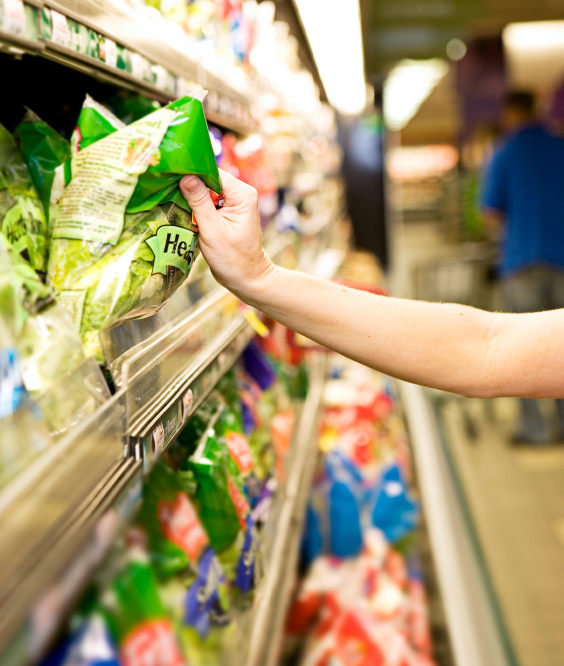
“Nutrition is a top priority for me and my family. Should I be moving toward more organic foods?”
According to studies by the Mayo Clinic, the FDA and the USDA, neither traditional farming nor alternative farming has an exclusive claim to better, more nutritious products. As noted above, food produced in the United States—whether by traditional or organic methods—is highly regulated for safety.
So, in the end, it all comes down to your personal preference. The important point is to feel good about all the healthy, safe food choices we have.
When providing meals for your family, your main concern should be balance. The food pyramid many of us grew up with has been modified into MyPyramid, and advocates whole grains, dark green vegetables, a variety of fruits, lean proteins and more. In addition, here are some recipes from moms like you.

Dr. Sam Beattie, Food Safety Specialist - Iowa State University Extension, says that side-by-side, organic and traditional foods are the same. Learn More
“We serve eggs at our house every morning. Is there an advantage to buying ‘cage-free’ and ‘free-range’?”
Eggs in general have numerous health benefits, no matter how they’re produced. They’re low in fat, high in protein, and a good source of iron, B vitamins and folate.
The terms “cage-free” and “free-range” describe alternate methods favored by some farmers, though the USDA has not produced a standardized definition for egg production. Cage-free chickens are typically uncaged within barns and warehouses, but do not necessarily have access to the outdoors. Free-range chickens generally have some outside access.
Some people assume that cage-free means chickens are treated more humanely than those housed in cages. Rest assured, animal behaviorists, veterinarians and scientists alike have studied the natural behaviors of chickens and have designed housing options to protect even the weakest of the bunch. Left to their own instincts, chickens may peck each other to death or eat whatever they find in open spaces, which can be reflected in their eggs. Responsible farmers will always provide the best care they can for their chickens, regardless of how they choose to raise them. If you're ever in doubt, why not ask some farmers yourself?
“I’ve heard there’s a link between high fructose corn syrup and childhood obesity. What’s the story?”
According to the American Dietetic Association, obesity (or excess body fat) occurs by taking in more calories than you burn. So that makes it difficult to point to any one food or sweetener as the cause. High fructose corn syrup has the same number of calories as table sugar and is equal in sweetness. It contains no artificial or synthetic ingredients. As with any sugar, moderation is key. In 2008, the American Medical Association (AMA) said, “After studying current research, the AMA concluded that high fructose syrup does not appear to contribute more to obesity than other caloric sweeteners…” The goal is to feed your family a healthy balance of fruits, vegetables, lean proteins and whole grains and limit their sugar intake, regardless if it’s table sugar or high fructose corn syrup. It’s also a good idea to limit your kids’ TV, computer and video time and encourage them to get about 60 minutes of physical activity a day.
“A few years ago, nobody ever talked about trans fats. Now they’re to be avoided. What prompted the sudden interest in trans fats?”
A by-product of the hydrogenation process, trans fatty acids—or trans fats—have been known in the scientific community for more than a hundred years. Only in the late 1980s did research link them to coronary artery disease; further studies have shown that trans fat has no health benefits, and have led to regulations and outright bans. From a nutritional standpoint, the fewer trans fats your family consumes, the better.
“Like all families I know these days, mine is on the go constantly. How can I provide the proper nutrition under such severe time constraints?”
A complete answer to this question would be worth a website of its own, but here are a handful of tips from a variety of sources:
- Set some time aside for food preparation, and make larger meals that can simply be heated throughout the next few days.
- Make more nutritious snacks available—raw veggies, nuts, cheese sticks, etc. If your family is used to more junk-food offerings, this might require a transition period.
- Drink water instead of soda or heavily sweetened fruit drinks; encourage your family to do the same.
- Have a plan when you shop for groceries, and don’t be tempted to throw convenient-but-less-nutritious items into your cart.
- If you’re eating lunch on the run, consider splitting the entrée with a friend.
- Don’t skip breakfast! Even a small, quick meal in the morning—whole-wheat toast, for instance—can keep you from craving empty-calorie snacks later in the day.
So in the end, it all comes down to your personal preference. The important point is to feel good about all the healthy, safe food choices we have.

“Conventionally and organically produced foods are no different in terms of nutritional quality or other health benefits.”
—Robert Gravani, PhD, Professor of Food Science, Cornell University
“Modern food technology and food processing has allowed for the development of a safer, more plentiful, and more sustainable food supply than ever before, and both fresh and processed foods can be safe, nutritious and environmentally responsible choices.”
—www.foodinsight.org,
“From Farm to Fork: What the Experts Say About Modern Food Production”
“For optimal health, consumers should continue to eat a balanced diet that includes significant amounts of fruits, vegetables and grains, regardless if such foods are produced by organic or by conventional practices.”
—Carl K. Winter, PhD, Director, Foodsafe Program, Extension Food Toxicologist, University of California, Davis




 choose 2 know your food
choose 2 know your food

